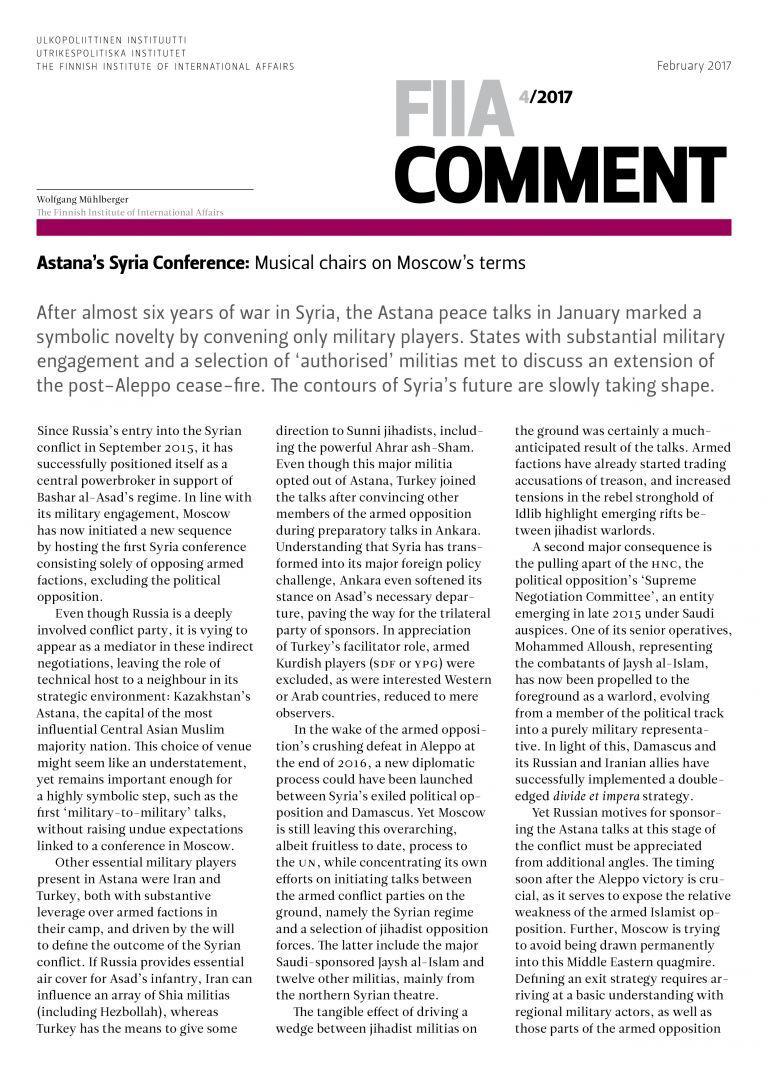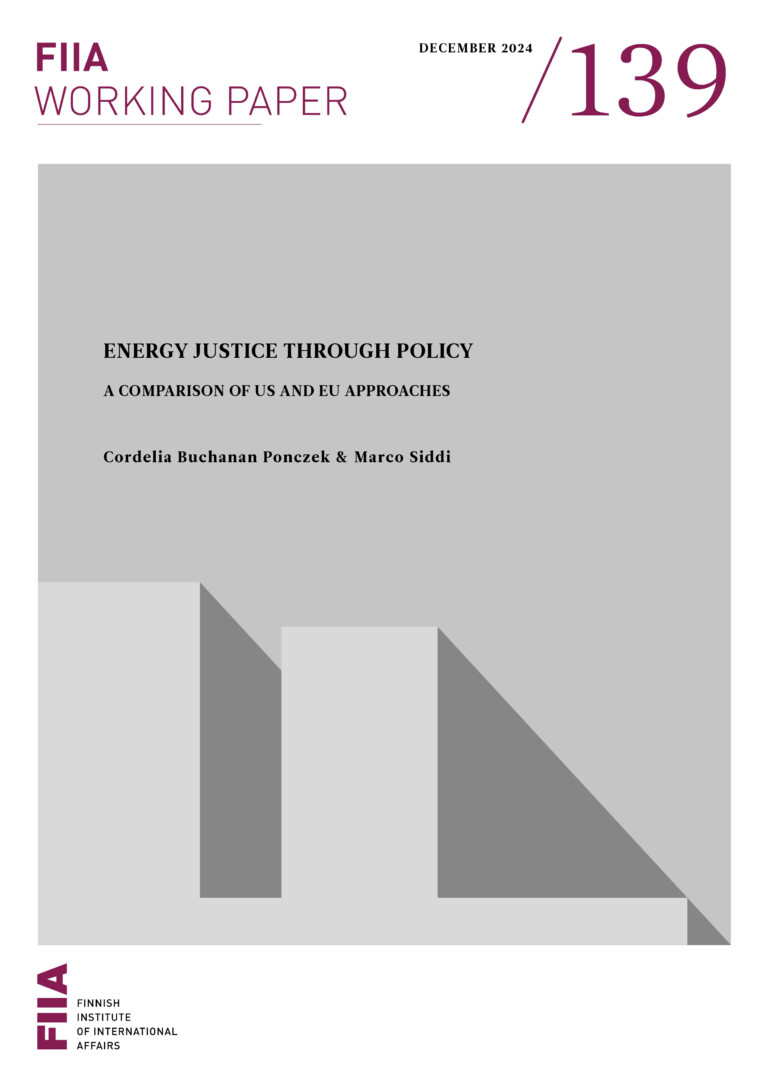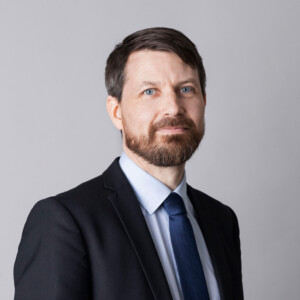After almost six years of war in Syria, the Astana peace talks in January marked a symbolic novelty by convening only military players. States with substantial military engagement and a selection of ‘authorised’ militias met to discuss an extension of the post-Aleppo cease-fire. The contours of Syria’s future are slowly taking shape.
Since Russia’s entry into the Syrian conflict in September 2015, it has successfully positioned itself as a central powerbroker in support of Bashar al-Asad’s regime. In line with its military engagement, Moscow has now initiated a new sequence by hosting the first Syria conference consisting solely of opposing armed factions, excluding the political opposition.
Even though Russia is a deeply involved conflict party, it is vying to appear as a mediator in these indirect negotiations, leaving the role of technical host to a neighbour in its strategic environment: Kazakhstan’s Astana, the capital of the most influential Central Asian Muslim majority nation. This choice of venue might seem like an understatement, yet remains important enough for a highly symbolic step, such as the first ‘military-to-military’ talks, without raising undue expectations linked to a conference in Moscow.
Other essential military players present in Astana were Iran and Turkey, both with substantive leverage over armed factions in their camp, and driven by the will to define the outcome of the Syrian conflict. If Russia provides essential air cover for Asad’s infantry, Iran can influence an array of Shia militias (including Hezbollah), whereas Turkey has the means to give some direction to Sunni jihadists, including the powerful Ahrar ash-Sham. Even though this major militia opted out of Astana, Turkey joined the talks after convincing other members of the armed opposition during preparatory talks in Ankara. Understanding that Syria has transformed into its major foreign policy challenge, Ankara even softened its stance on Asad’s necessary departure, paving the way for the trilateral party of sponsors. In appreciation of Turkey’s facilitator role, armed Kurdish players (SDF or YPG) were excluded, as were interested Western or Arab countries, reduced to mere observers.
In the wake of the armed opposition’s crushing defeat in Aleppo at the end of 2016, a new diplomatic process could have been launched between Syria’s exiled political opposition and Damascus. Yet Moscow is still leaving this overarching, albeit fruitless to date, process to the UN, while concentrating its own efforts on initiating talks between the armed conflict parties on the ground, namely the Syrian regime and a selection of jihadist opposition forces. The latter include the major Saudi-sponsored Jaysh al-Islam and twelve other militias, mainly from the northern Syrian theatre.
The tangible effect of driving a wedge between jihadist militias on the ground was certainly a much-anticipated result of the talks. Armed factions have already started trading accusations of treason, and increased tensions in the rebel stronghold of Idlib highlight emerging rifts between jihadist warlords.
A second major consequence is the pulling apart of the HNC, the political opposition’s ‘Supreme Negotiation Committee’, an entity emerging in late 2015 under Saudi auspices. One of its senior operatives, Mohammed Alloush, representing the combatants of Jaysh al-Islam, has now been propelled to the foreground as a warlord, evolving from a member of the political track into a purely military representative. In light of this, Damascus and its Russian and Iranian allies have successfully implemented a double-edged divide et impera strategy.
Yet Russian motives for sponsoring the Astana talks at this stage of the conflict must be appreciated from additional angles. The timing soon after the Aleppo victory is crucial, as it serves to expose the relative weakness of the armed Islamist opposition. Further, Moscow is trying to avoid being drawn permanently into this Middle Eastern quagmire. Defining an exit strategy requires arriving at a basic understanding with regional military actors, as well as those parts of the armed opposition open to a modicum of pragmatism. A vague agreement on a yet to be more clearly defined ceasefire might therefore serve as a useful launching pad to portray unity of purpose for the hosts. Nevertheless, divergences amongst the three sponsors about the future role of the Kurds, Hezbollah units, or specific parameters of a peace process still have the potential to undermine the extension of the ceasefire.
The formal outcome of the Astana gathering corresponds to a military settlement with potentially far-reaching political implications. In order to de-escalate armed confrontations, the three sponsors signed a self-referential ‘joint declaration’, albeit rejected by the Syrian government and the armed opposition alike. Its purpose is to set up a trilateral commission to monitor the ceasefire. Yet the agreement is lacking both incentives for implementation and penalties for non-compliance. In practice, hosting the conference corresponds to a symbolic closing of ranks among the three sponsors, including the goal to establish Astana as the future centre for political negotiations, as mentioned in the final communiqué.
Hence, a central question is how Astana will feed into the UN process in Geneva, the venue for cumbersome formal peace talks on a political solution. Certainly, it must be considered that the meeting in Kazakhstan unleashed a new dynamic, based on more realpolitik parameters such as prioritising effective military might on the ground for negotiations. Moscow’s ensuing efforts at pushing for acceptance of its own draft for a Syrian constitution highlight its drive for seizing the post-Aleppo momentum and at defining the terms of Syria’s political future. Under these circumstances, Russia’s declared support for the UN-led peace process, which has hardly been constructive to date, will remain mere lip service unless future negotiations in Geneva factor in the building blocks of the emerging pax russica.









